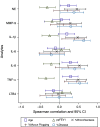Airway Inflammation in Children with Primary Ciliary Dyskinesia
- PMID: 35984413
- PMCID: PMC9819265
- DOI: 10.1513/AnnalsATS.202204-314OC
Airway Inflammation in Children with Primary Ciliary Dyskinesia
Abstract
Rationale: The role of airway inflammation in disease pathogenesis in children with primary ciliary dyskinesia (PCD) is poorly understood. Objectives: We investigated relationships between sputum inflammation measurements, age, lung function, bronchiectasis, airway infection, and ultrastructural defects in children with PCD. Methods: Spontaneously expectorated sputum was collected from clinically stable children and adolescents with PCD ages 6 years and older participating in a multicenter, observational study. Sputum protease and inflammatory cytokine concentrations were correlated with age, lung function, and chest computed tomography measures of structural lung disease, whereas differences in concentrations were compared between ultrastructural defect categories and between those with and without detectable bacterial infection. Results: Sputum from 77 children with PCD (39 females [51%]; mean [standard deviation] age, 13.9 [4.9] yr; mean [standard deviation] forced expiratory volume in 1 second [FEV1]% predicted, 80.8 [20.5]) was analyzed. Sputum inflammatory marker measurements, including neutrophil elastase activity, IL-1β (interleukin-1β), IL-8, and TNF-α (tumor necrosis factor α) concentrations, correlated positively with age, percentage of bronchiectasis, and percentage of total structural lung disease on computed tomography, and negatively with lung function. Correlations between neutrophil elastase concentrations and FEV1% predicted and percentage of bronchiectasis were -0.32 (95% confidence interval, -0.51 to -0.10) and 0.46 (0.14 to 0.69), respectively. Sputum neutrophil elastase, IL-1β, and TNF-α concentrations were higher in those with detectable bacterial pathogens. Participants with absent inner dynein arm and microtubular disorganization had similar inflammatory profiles compared with participants with outer dynein arm defects. Conclusions: In this multicenter pediatric PCD cohort, elevated concentrations of sputum proteases and cytokines were associated with impaired lung function and structural damage as determined by chest computed tomography, suggesting that sputum inflammatory measurements could serve as biomarkers in PCD.
Keywords: biomarkers; bronchiectasis; inflammation; lung function; sputum.
Figures


Comment in
-
Preventing Continuous Damage in Primary Ciliary Dyskinesia: Is Airway Inflammation a Potential Target?Ann Am Thorac Soc. 2023 Jan;20(1):26-27. doi: 10.1513/AnnalsATS.202209-782ED. Ann Am Thorac Soc. 2023. PMID: 36584988 Free PMC article. No abstract available.
References
-
- Brown DE, Pittman JE, Leigh MW, Fordham L, Davis SD. Early lung disease in young children with primary ciliary dyskinesia. Pediatr Pulmonol . 2008;43:514–516. - PubMed
-
- Marthin JK, Petersen N, Skovgaard LT, Nielsen KG. Lung function in patients with primary ciliary dyskinesia: a cross-sectional and 3-decade longitudinal study. Am J Respir Crit Care Med . 2010;181:1262–1268. - PubMed
-
- Green K, Buchvald FF, Marthin JK, Hanel B, Gustafsson PM, Nielsen KG. Ventilation inhomogeneity in children with primary ciliary dyskinesia. Thorax . 2012;67:49–53. - PubMed
Publication types
MeSH terms
Substances
Grants and funding
LinkOut - more resources
Full Text Sources
Medical

